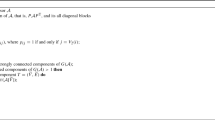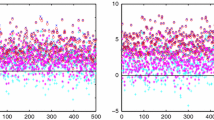Abstract
We introduce a new class of nonnegative tensors-strictly nonnegative tensors. A weakly irreducible nonnegative tensor is a strictly nonnegative tensor but not vice versa. We show that the spectral radius of a strictly nonnegative tensor is always positive. We give some necessary and sufficient conditions for the six well-conditional classes of nonnegative tensors, introduced in the literature, and a full relationship picture about strictly nonnegative tensors with these six classes of nonnegative tensors. We then establish global R-linear convergence of a power method for finding the spectral radius of a nonnegative tensor under the condition of weak irreducibility. We show that for a nonnegative tensor T, there always exists a partition of the index set such that every tensor induced by the partition is weakly irreducible; and the spectral radius of T can be obtained from those spectral radii of the induced tensors. In this way, we develop a convergent algorithm for finding the spectral radius of a general nonnegative tensor without any additional assumption. Some preliminary numerical results show the feasibility and effectiveness of the algorithm.
Similar content being viewed by others
References
Berman A, Plemmom R. Nonnegative Matrices in the Mathematical Sciences. New York: Academic Press, 1979
Chang K C. A nonlinear Krein Rutman theorem. J Syst Sci Complex, 2009, 22: 542–554
Chang K C, Pearson K, Zhang T. Perron-Frobenius theorem for nonnegative tensors. Commun Math Sci, 2008, 6: 507–520
Chang K C, Pearson K, Zhang T. Primitivity, the convergence of the NZQ method, and the largest eigenvalue for nonnegative tensors. SIAM J Matrix Anal Appl, 2011, 32: 806–819
Chang K C, Pearson K, Zhang T. Some variational principles of the Z-eigenvalues for nonnegative tensors. Linear Algebra Appl, 2013, 438: 4166–4182
Chang K C, Qi L, Zhang T. A survey on the spectral theory of nonnegative tensors. Numer Linear Algebra Appl, doi: 10.1002/nla.1902, 2013
Chang K C, Zhang T. On the uniqueness and non-uniqueness of the positive Z-eigenvector for transition probability tensors. J Math Anal Appl, 2013, 408: 525–540
Friedland S, Gaubert S, Han L. Perron-Frobenius theorem for nonnegative multilinear forms and extensions. Linear Algebra Appl, 2013, 438: 738–749
Gaubert S, Gunawardena J. The Perron-Frobenius theorem for homogeneous, monotone functions. Trans Amer Math Soc, 2004, 356: 4931–4950
Hu S L, Qi L. Convergence of a second order Markov chain. ArXiv:1307.6919, 2013
Hu S L, Qi L, Zhang G. The geometric measure of entanglement of pure states with nonnegative amplitudes and the spectral theory of nonnegative tensors. ArXiv:1203.3675, 2012
Lim L H. Singular values and eigenvalues of tensors: A variational approach. In: Computational Advances in Multi-Sensor Adaptive Processing, vol. 1. Puerto Vallarta: IEEE, 2005, 129–132
Liu Y, Zhou G L, Ibrahim N F. An always convergent algorithm for the largest eigenvalue of an irreducible nonnegative tensor. J Comput Appl Math, 2010, 235: 286–292
Ng M, Qi L, Zhou G L. Finding the largest eigenvalue of a non-negative tensor. SIAM J Matrx Anal Appl, 2009, 31: 1090–1099
Nussbaum R D. Hilbert’s Projective Metric and Iterated Nonlinear Maps. Boston, MA: Amer Math Soc, 1988
Pearson K J. Essentially positive tensors. Internat J Algebra, 2010, 4: 421–427
Qi L. Eigenvalues of a real supersymmetric tensor. J Symbolic Comput, 2005, 40: 1302–1324
Yang Q, Yang Y. Further results for Perron-Frobenius theorem for nonnegative tensors II. SIAM J Matrix Anal Appl, 2011, 32: 1236–1250
Yang Y, Yang Q. Further results for Perron-Frobenius theorem for nonnegative tensors. SIAM J Matrix Anal Appl, 2010, 31: 2517–2530
Yang Y, Yang Q. Singular values of nonnegative rectangular tensors. Front Math China, 2011, 6: 363–378
Yang Y, Yang Q. Geometric simplicity of spectral radius of nonnegative irreducible tensors. Front Math China, 2013, 8: 129–140
Yang Y, Yang Q, Li Y. An algorithm to find the spectral radius of nonnegative tensors and its convergence analysis. ArXiv:1102.2668, 2011
Zhang L, Qi L. Linear convergence of an algorithm for computing the largest eigenvalue of a nonnegative tensor. Numer Linear Algebra Appl, 2012, 19: 830–841
Zhang L, Qi L, Luo L, et al. The dominant eigenvalue of an essentially nonnegative tensor. Numer Linear Algebra Appl, in press, 2013
Zhang L, Qi L, Xu Y. Linear convergence of the LZI algorithm for weakly positive tensors. J Comput Math, 2012, 30: 24–33
Zhang L, Qi L, Zhou G. M-tensors and the positive definiteness of a multivariate form. ArXiv:1202.6431, 2012
Zhou G L, Caccetta L, Qi L. Convergence of an algorithm for the largest singular value of a nonnegative rectangular tensor. Linear Algebra Appl, 2013, 438: 959–968
Author information
Authors and Affiliations
Corresponding author
Rights and permissions
About this article
Cite this article
Hu, S., Huang, Z. & Qi, L. Strictly nonnegative tensors and nonnegative tensor partition. Sci. China Math. 57, 181–195 (2014). https://doi.org/10.1007/s11425-013-4752-4
Received:
Accepted:
Published:
Issue Date:
DOI: https://doi.org/10.1007/s11425-013-4752-4




